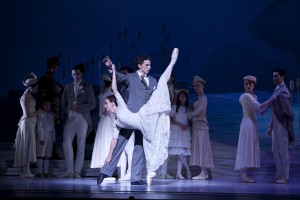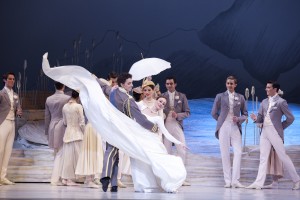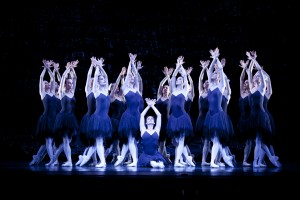While it sounded unpredictable on paper, the 12th season of Glorya Kaufman Presents Dance at the Music Center opened on a high note with the West Coast debut of Australian Ballet’s “Swan Lake,” choreographer Graeme Murphy’s 2002 reimagining of Tchaikovsky’s epic beauty through the lens of the Princess Diana tragedy.

The Australian Ballet’s Madeleine Eastoe and Kevin Jackson in Graeme Murphy’s “Swan Lake.” Photo: Lisa Tomasetti
Though a hybrid concoction – mixing contemporary dance with classical jumps and fouettés, Edwardian sets with an accessible 20th century memory – this ballet is so well woven, designed and performed, its easy standing ovation on opening night showed it wrestled many a Balanchine devotee and ballet purist to its side.
That there was a small flood at the Dorothy Chandler Pavilion lobby beforehand (the building celebrates its 50th anniversary this year) unraveled the usual sparkly entr’acte of a ballet premiere. Yet as soon as Australian conductor Nicolette Fraillon took up the baton and the curtain rose on scenic designer Kristian Fredrickson’s dignified gray-and-white Act I wedding environs, the cool, complete beauty immediately satisfied the yen for classical ballet’s physical and environmental elevation.
The production, at very first, actually felt a little pushy. There was a prologue, before the wedding scene commenced, set in Prince Siegfried’s silky black boudoir, where a barely dressed couple tempted and lunged for one another with both fine gestures and distorting lasciviousness. Yet set in the downstage right corner, the swift progress of this barreling-hot duo – from teasing hand gestures to mounted union on the sheets – made for a kind of compass rose or legend to guide this particular “Swan Lake” map all night. Here, Siegfried (Kevin Jackson) and the married Baroness von Rothbart (Lana Jones) were headed due South, away from heart and head, subsumed in a foundation of craving lust. In public, dressed up with ancestral carriage and class, the duo hummed perfectly, a carnal V12 engine.

The Australian Ballet’s Madeleine Eastoe and Kevin Jackson in Graeme Murphy’s “Swan Lake.” Photo: Lisa Tomasetti
Competing against this base, aristocratic force field, on her swoony-white wedding day, the tragically unformed Odette (Madeleine Eastoe) becomes a trapped, reactive creature. Attempting to ignore, then separate, then join with the pair, Odette falls flat again and again, looking pitifully young or stuffily old – nothing in between. The calcified Queen (Shane Carroll) doesn’t help at all. While Odette tried to skate the surface, the chorus and principals both keep descending, plunging to the floor in dazzling shapes, identifying territory she knew nothing about.
In a narrative that functions a bit more like “Giselle” than “Swan Lake,” there was a tour de force mad scene (that beautifully employed Odette’s classic chaine and fouetté turns) and the ax had pretty much fallen by the end of Act I for the two principals.
With no supernatural plot lines or confusing telenovela twists to come, this “Swan Lake” then allowed for deeper wallowing in Act II’s blue- and silver-lit lakeside dreamscapes, where – born from Diana’s imagination at a mental hospital – swans flocked and lovers discovered each other anew. Surrounded by swans on an angled circular platform at the back of the stage, Odette found her place on the floor. With Prince Siegfried, she claimed her airborne territory.
In Act III, when a steely, ghost-pale Odette re-emerged at a gala at the Baronesses’ opaque black ballroom – in reality she only moved from one castellated institution to another now – it was like a revelation from Poe or Mary Shelley – the fateful eruption of the disavowed, come to hollow out the guts of the ones who will live on.
Besides this great story, enough cannot be said about the unique visceral stamp of this company: weighty and momentous movement attack, deliriously seamless partnering, serious acting chops from all. They animated Murphy’s uncluttered, perseverating movement phrasing with a confidence and conviction that extended the narrative’s sorrowful human tale.
